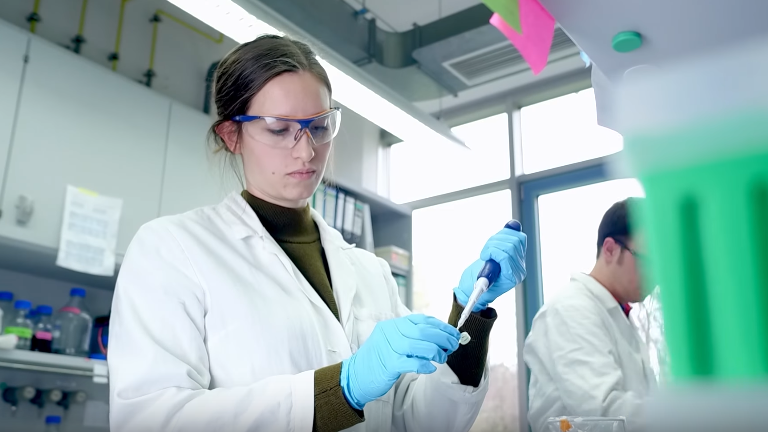German scientists have developed an effective way to absorb carbon dioxide from the air

Despite the huge variety of organisms capable of producing enzymes to convert carbon dioxide into organic compounds, so far no one has been able to use this opportunity to convert CO 2 into biofuels or renewable sources to produce valuable chemicals. A too high concentration of carbon dioxide in the atmosphere is a serious problem, but some scientists see it as an opportunity.
A team of researchers from the Max Planck Society for Earth Microbiology Institute in Marburg, Germany, has developed a new, highly efficient method for CO2 processing for plants. It is based on a new enzyme for carbon sequestration , thanks to which this process can hypothetically go 2-3 times faster.
')
Plants and algae do quite well in order to reduce the amount of carbon dioxide in the atmosphere. Every year they consume about 350 billion tons of CO 2 worldwide. Almost all plants do this through the same chemical process, a series of chemical reactions called the Calvin cycle .
The Calvin cycle is a set of molecular transformations, during which three simple atoms of a CO 2 molecule are slowly converted into glucose, a complex sugar. This method is quite well debugged by evolution, but scientists have found a way to improve it.
The successful completion of the Calvin cycle depends on the specific molecular tool - ribulose bisphosphate carboxylase (RuBisCO) - an enzyme that captures CO 2 from the atmosphere and forms a large molecule to start the transformation. The problem is that RuBisCO does this relatively slowly. In addition, every fifth attempt by RuBisCO to fix CO 2 leads to carbon losses from the Calvin cycle and reduces the efficiency of photosynthesis.
Biochemists led by Tobias Erb have developed in vitro carbon absorption cycle, in many respects similar to the Calvin cycle. The main difference of the new method is that it uses a faster and more efficient molecular tool - the ECR enzyme, which performs the same work as RuBisCO, only about 9 times faster. Erb called this process the CETCH cycle. In addition to the ECR enzyme, scientists have sequenced and synthesized another 16 catalysts from 9 different organisms for the CETCH cycle.
The CETCH cycle converts airborne CO 2 to glyoxylate in 11 steps. An enzyme that transforms molecules is required at each stage. Each of these enzymes was carefully selected from 40,000 known catalysts. Some of them were found in humans and intestinal bacteria, others were taken from plants and microbes living in the oceans.
Erb and his colleagues checked the CETCH cycle in their lab. They connected all the produced catalysts with some chemical fuel and calculated how much carbon dioxide was removed from the air. They found that their cycle is 25% more efficient than the Calvin cycle in plants and algae. CETCH converts carbon dioxide to organic molecules at a rate of 5 nmol CO 2 per minute per milligram of protein.
Encouraged by the successful restoration of a synthetic enzymatic network in a test tube, which, moreover, can compete with natural cycles, Erb opens several doors at once for using CETCH technology. If synthetic enzymes are introduced into a living organism, the CETCH cycle will support natural photosynthesis. In the end, it can also serve as an impetus for the development of a self-sufficient, fully synthetic carbon metabolism in bacterial and algal systems.
Erb notes that at this stage it is very difficult to predict how fast the synthesized CETCH will be compared to the Calvin cycle, which works in living organisms. But since it goes through fewer steps and its enzymes are faster, scientists expect it to accelerate two or three times. In the end, he may be a little slower than the Calvin cycle. Scientists just don't know for sure yet.
Although glyoxylate, which is produced during the CETCH cycle, is largely useless on its own, it can easily be converted to another chemical substance suitable for the production of biofuels or antibiotics.
Scientists hope that one day the CETCH cycle can be introduced into a living organism using genetic engineering techniques. However, this is a very difficult task, which requires a lot of research. Now Erb’s team has no idea what will happen if their cycle is located inside the living cell system.
“Try to imagine that scientists managed to create something like artificial leaves or any other hybrid system in which photovoltaic solar cells can provide energy to the algae and the bacteria living under them. Then, using the CETCH cycle, they can absorb carbon dioxide and produce useful chemicals, ”says Tobias Erb.
Now the basis of the entire chemical industry is the use of fossil fuels. Plastics and textiles, technology and antibiotics - all this is produced with a huge amount of carbon dioxide emissions. Instead of burdening the planet with new emissions, chemical manufacturing could actively tackle climate change by creating useful CO 2 products.
Scientific work published in the journal Science November 18, 2016
DOI: 10.1126 / science.aah5237
Source: https://habr.com/ru/post/399203/
All Articles